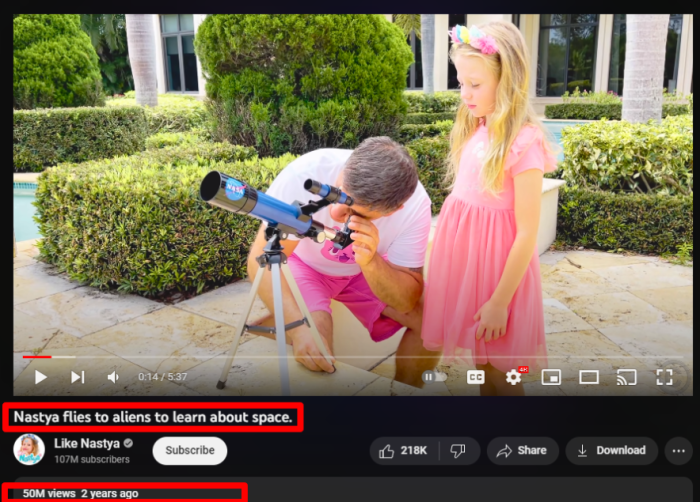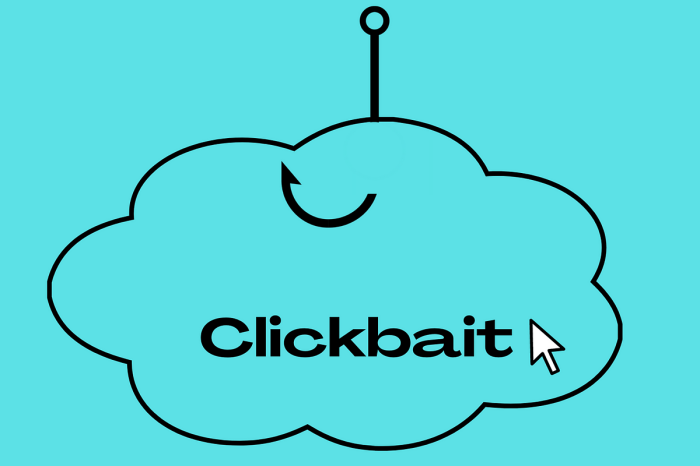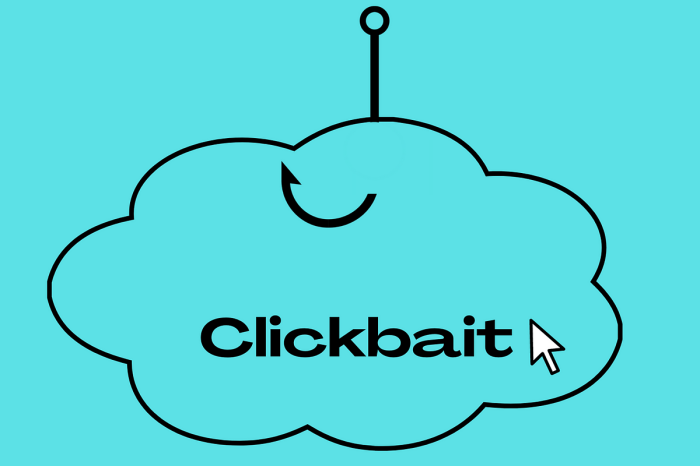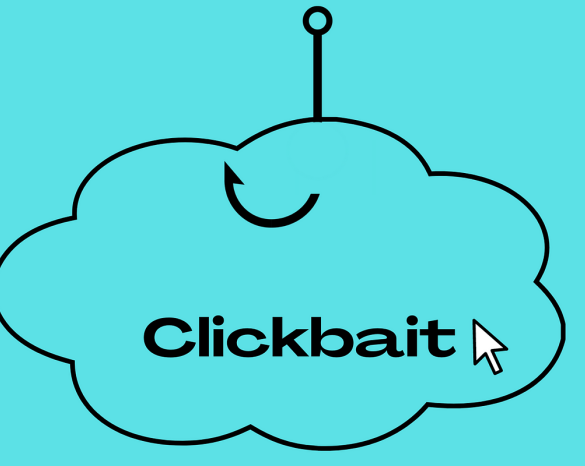5 clickbait examples and why they work. Unmasking the seductive strategies behind captivating headlines, this exploration delves into the psychology of online attention-grabbing content. We’ll dissect five compelling examples, exposing the manipulative techniques used to entice clicks. From emotional appeals to exploiting curiosity, understanding these tactics empowers you to navigate the digital landscape with discernment.
This piece will define clickbait, explore the psychological triggers, and examine five specific examples. We’ll analyze the techniques behind their effectiveness, and the consequences of succumbing to these tactics. Ultimately, we aim to demystify the world of clickbait, allowing readers to critically evaluate online content.
Defining Clickbait

Clickbait is a ubiquitous element of the online landscape, a siren song designed to lure users into clicking a link. It’s a form of content creation that prioritizes attracting attention over delivering genuine value, often relying on sensationalism, misleading headlines, and emotional triggers. Understanding what constitutes clickbait is crucial for navigating the internet responsibly and recognizing deceptive practices.Defining clickbait precisely is challenging due to its constantly evolving nature.
Different individuals and organizations may have varying interpretations, but core characteristics generally align. This analysis will delve into the characteristics of clickbait, and provide examples to illustrate the concept more clearly.
Five Definitions of Clickbait
Understanding clickbait requires looking at it from various angles. Here are five definitions that capture different facets of the phenomenon:
- Clickbait is content designed primarily to generate clicks rather than to provide useful or informative content. It often employs sensationalist language, misleading headlines, and exaggerated claims to provoke curiosity and drive traffic to a website.
- Clickbait is a form of online content that uses manipulative tactics to encourage clicks, often prioritizing the quantity of clicks over the quality of the content or the user experience. These tactics can include clickbait titles, provocative images, or emotionally charged language.
- Clickbait is a method of attracting attention to a piece of content by exploiting human psychology. This method often relies on curiosity, fear, or a desire for instant gratification, using language or imagery that suggests something exciting or surprising awaits the reader.
- Clickbait is content that utilizes deceptive or misleading techniques to entice users into clicking a link, frequently promising something that isn’t actually delivered. The core intent is to maximize click-through rates rather than provide value.
- Clickbait is a form of online advertising that relies on the user’s desire for instant gratification and excitement. It employs provocative titles, eye-catching images, and emotional appeals to capture attention and induce a click. This is done often without regard to the actual quality of the content behind the link.
Key Characteristics of Clickbait
Clickbait content often shares certain common traits. Identifying these characteristics helps differentiate it from legitimate content.
| Definition | Characteristics | Example |
|---|---|---|
| Content designed to maximize clicks over providing value. | Sensationalist headlines, exaggerated claims, emotional language, misleading visuals. | “You Won’t Believe What Happened Next!” |
| Content using manipulative tactics for clicks. | Provocative titles, clickbait questions, overly dramatic descriptions, use of urgency (e.g., “limited time offer”). | “OMG! You won’t believe this!” |
| Content exploiting human psychology for attention. | Creating curiosity, playing on fears, or promising instant gratification. | “This shocking secret will change your life!” |
| Content employing deceptive techniques for clicks. | Misleading thumbnails, exaggerated promises, false claims or promises. | “The one thing you need to know about…” |
| Content that prioritizes click-through rates over value. | Short attention spans, low quality content, often linked to irrelevant content. | “This picture is going viral! See what it is!” |
Examples of Non-Clickbait Content, 5 clickbait examples and why they work
Here are examples of content that does not fall under the clickbait category.
- A detailed article explaining a complex scientific concept.
- A well-researched analysis of a historical event.
- A comprehensive review of a product or service.
- A personal blog post sharing genuine experiences and insights.
- A factual news report.
Identifying Clickbait Tactics
Clickbait, with its irresistible allure, often tricks us into clicking on links with promises of juicy secrets, mind-blowing revelations, or captivating stories. Understanding the psychological hooks that lure us into this digital trap is crucial for navigating the online landscape with more discernment. This exploration delves into the common tactics employed in clickbait, examining the emotional triggers and manipulative headlines designed to snag our attention.Clickbait thrives on exploiting our innate human desires for knowledge, connection, and excitement.
It preys on our vulnerabilities, utilizing emotional appeals and psychological triggers to manipulate our decision-making processes. By understanding these mechanisms, we can better recognize and resist the seductive pull of clickbait headlines.
Psychological Triggers in Clickbait
Clickbait masters leverage various psychological triggers to draw in unsuspecting readers. These triggers tap into our primal responses, creating a sense of urgency, curiosity, or fear that compels us to click. Understanding these triggers can empower us to make more conscious choices about the content we engage with online.
Emotional Appeals in Clickbait
Clickbait often leverages our emotions to entice us. These emotional appeals play on our desire for validation, excitement, fear, or belonging. They can range from eliciting a thrill to instilling a sense of dread or urgency. Clickbait creators meticulously craft their headlines and content to trigger these emotional responses, hoping to capture our attention and keep us engaged.
Examples of Clickbait Headlines Evoking Strong Emotional Responses
Here are some examples of headlines designed to evoke strong emotional responses, showcasing how clickbait creators exploit our vulnerabilities:
| Trigger | Explanation | Example Headline |
|---|---|---|
| Curiosity | These headlines pique our interest by posing intriguing questions or promising hidden information. | “You Won’t BELIEVE What Happened Next!” |
| Fear | Fear-based headlines often play on our anxieties and insecurities, generating a sense of urgency and potential danger. | “Scientists Warn: This Could Destroy Humanity!” |
| Excitement | Clickbait headlines that focus on excitement use words like “amazing,” “unbelievable,” or “shocking” to lure readers in with the promise of something extraordinary. | “This Viral Video Will SHOCK You!” |
| Validation | These headlines promise to confirm or expose something that aligns with pre-existing beliefs or values. | “Is Your Favorite Celebrity Secretly…?” |
| Scarcity | These headlines create a sense of urgency by suggesting limited availability or a rapidly expiring opportunity. | “Only 24 Hours Left! This Deal Won’t Last!” |
Examining Clickbait Examples
Clickbait headlines are designed to grab attention and entice users to click. Understanding how they work involves recognizing the specific emotional triggers and manipulation techniques employed. This section delves into five clickbait examples, highlighting the emotional responses they aim to evoke and the strategies used to achieve this.
Clickbait Headline Analysis
Clickbait headlines often rely on a combination of emotional appeals and intriguing statements to compel readers to click. They exploit our natural curiosity and desire for information, often exaggerating or misrepresenting the content behind the link. This analysis demonstrates how these techniques manipulate reader expectations.
| Headline | Emotional Response | Manipulation Technique | Explanation |
|---|---|---|---|
| “You Won’t BELIEVE What Happened Next!” | Curiosity, Excitement | Intrigue, Anticipation | The headline uses strong emotional language (“Won’t BELIEVE”) and implies a surprising, impactful event. This creates a sense of urgency and anticipation, prompting users to click to discover what happened. |
| “This SHOCKING Secret Will Change Your Life Forever!” | Hope, Desire for Improvement | Promise of Transformation | The headline plays on the desire for personal growth and improvement. The word “shocking” and the promise of a life-altering secret create a strong emotional appeal, making the headline highly enticing. |
| “OMG! This Viral Photo Will Make You CRY!” | Emotional Connection, Empathy | Emotional Manipulation | The headline uses emotionally charged language (“OMG,” “CRY”) to connect with readers on an emotional level. The word “viral” adds social proof, suggesting that others have experienced the emotion and prompting the user to feel included in a shared experience. |
| “10 Signs You’re A Genius (You’ll Be Shocked!)” | Pride, Self-Esteem | Validation, Flattery | This headline plays on the desire for self-validation. The promise of discovering a hidden talent or ability (“genius”) and the use of an exclamation mark creates a sense of excitement and intrigue. |
| “Scientists Discovered a Secret About Happiness That Will Blow Your Mind!” | Curiosity, Desire for Knowledge | Authority, Scientific Appeal | The headline combines the appeal to authority (scientists) with a sensational claim (“blow your mind”). This blend creates a sense of credibility and wonder, tempting readers to learn more. |
Analyzing Clickbait Success

Clickbait, while often criticized, is a powerful tool in the digital age. Understanding its success is crucial for anyone navigating the online landscape, whether as a content creator or a consumer. This analysis delves into the key elements driving clickbait’s effectiveness, comparing and contrasting different strategies to offer a deeper understanding.Clickbait’s effectiveness stems from its ability to exploit psychological triggers in users.
These triggers, carefully designed and deployed, often lead to an initial, impulsive click. However, the long-term success of a clickbait piece depends on its ability to deliver on a promise, even if that promise is often veiled in exaggeration or sensationalism. Successful clickbait taps into pre-existing interests and anxieties, offering a seemingly quick fix or answer to a problem.
Ultimately, understanding how these strategies work can help us navigate the digital world with a more critical eye.
Key Elements of Clickbait Success
Clickbait’s success hinges on several interconnected elements. These are not always employed in isolation but rather work together to create an enticing and often irresistible call to action. The effectiveness of each element can vary depending on the specific target audience and the context of the platform.
- Intrigue and Curiosity: A crucial aspect of clickbait is piquing the reader’s curiosity. This is often achieved by employing vague or intriguing language, creating a sense of mystery and anticipation. This curiosity is intensified by employing questions or incomplete sentences in the headline, enticing the user to discover the answer or complete the thought.
- Emotional Appeal: Clickbait often leverages emotions such as fear, anger, or excitement. By triggering these emotions, clickbait can create a stronger sense of urgency and compel the reader to click to alleviate the perceived threat or fulfill the desire.
- Sensationalism and Exaggeration: Overstating the importance or value of the content is a common tactic. Clickbait often uses dramatic language, hyperbole, and unexpected turns to grab attention. This can range from dramatic claims about celebrity relationships to the latest scientific discoveries.
- Urgency and Scarcity: Creating a sense of urgency, often by suggesting limited availability or time sensitivity, can drive immediate clicks. Phrases like “limited time offer” or “exclusive access” exploit this psychological trigger.
- Relevance and Familiarity: Clickbait often plays on subjects that resonate with the target audience’s interests and concerns. It uses familiar language, themes, or topics that the reader can readily relate to, making the content appear more relevant and important.
Comparison of Clickbait Strategies
Different clickbait strategies can vary in their effectiveness. While some strategies focus on exploiting curiosity, others prioritize emotional manipulation or a sense of urgency. The effectiveness of each approach depends on the specific context and the target audience. For example, a clickbait article about a celebrity breakup might utilize emotional appeal and sensationalism, while a clickbait article about a new product might emphasize scarcity and urgency.
Ever wondered why some headlines practically scream at you? It’s all about clickbait, of course! We’ve all seen those headlines promising “5 things you NEED to know about X.” Understanding why they work is key, and often relates to how Google Ads fractional conversions work. These conversions, as explained in this insightful article on fractional conversions, what are google ads fractional conversions and why do they exist , are a fascinating area of digital marketing.
But back to clickbait, understanding these tactics can help you recognize and avoid getting caught in the trap, allowing you to better evaluate your own marketing strategies.
| Element | Explanation | Example |
|---|---|---|
| Intrigue & Curiosity | Creates mystery and anticipation by using vague or intriguing language, often through incomplete sentences or questions in the headline. | “You Won’t Believe What Happened Next…” |
| Emotional Appeal | Evokes strong emotions (fear, anger, excitement) to create a sense of urgency and compel the reader to click. | “This Will SHOCK You!” or “The Heartbreaking Truth…” |
| Sensationalism & Exaggeration | Overstates the importance or value of the content using dramatic language, hyperbole, and unexpected turns. | “World’s Biggest…” or “The Most Amazing…” |
| Urgency & Scarcity | Creates a sense of urgency by suggesting limited availability or time sensitivity. | “Limited Time Offer! Only 24 Hours Left!” |
| Relevance & Familiarity | Focuses on topics relevant to the audience’s interests, using familiar language and themes to increase relatability. | “Top 10 Tips for…” or “The Ultimate Guide to…” |
Dissecting the Impact of Clickbait
Clickbait, with its alluring promises and sensational headlines, has become a ubiquitous feature of the online landscape. While its effectiveness in driving traffic is undeniable, the impact it has on users and the broader online environment warrants careful consideration. This exploration delves into the potential consequences of encountering clickbait, examining its influence on online behavior, and presenting examples of its negative effects.The seemingly harmless act of clicking on a tantalizing headline can have a far-reaching impact, both individually and collectively.
Understanding these consequences is crucial to navigating the online world responsibly and critically evaluating the information we encounter.
Ever wondered how clickbait titles grab your attention? It’s all about triggering curiosity, right? Well, Netflix does something similar, using sophisticated algorithms to predict what you want to watch next. Learning how Netflix measures you, like a modern-day clickbait expert, reveals how deeply they understand your viewing habits. This knowledge, in turn, helps them tailor recommendations and ultimately, create a more engaging experience.
Ultimately, understanding these clickbait tactics is key to knowing what makes them so effective, whether it’s a sensational headline or a tailored movie suggestion. how netflix measures you
Potential Consequences of Encountering Clickbait
Clickbait often relies on misleading or exaggerated content to entice clicks. This can lead to a frustrating experience for the user, who may find the content significantly different from the initial promise. The frustration stems from the mismatch between expectation and reality, and this disappointment can erode trust in online sources. Moreover, the constant bombardment of clickbait can contribute to a sense of cynicism and skepticism toward online information in general.
Influence of Clickbait on Online Behavior
Clickbait’s impact on online behavior is multifaceted. The constant pursuit of immediate gratification, driven by the allure of clickbait, can discourage in-depth engagement with content. Users may become accustomed to superficial information, prioritizing speed over substance. This trend can hinder critical thinking skills and the development of nuanced perspectives. Furthermore, the reliance on clickbait can lead to a shortened attention span, as users are constantly seeking the next exciting headline.
Ever wondered why some headlines grab your attention instantly? We’ll dissect 5 clickbait examples and explore the psychology behind their effectiveness. Understanding these tricks can help you in your own digital marketing efforts, like determining if your SEO is actually working for your website. A great resource for understanding if your website is seeing positive results from your SEO strategy is this guide.
Ultimately, mastering these tactics, and understanding what makes clickbait tick, is key to optimizing your own content for maximum impact.
Negative Impacts of Clickbait
Clickbait’s detrimental effects are not limited to individual user experiences. Here are five ways clickbait can negatively impact the online world:
- Erosion of Trust in Online Information: The prevalence of clickbait can erode trust in online information sources. Users, having been repeatedly misled by clickbait headlines, may become skeptical of all online content, hindering the dissemination of reliable information. This erosion of trust creates a climate where misinformation and disinformation can thrive.
- Reduced Engagement with Quality Content: Clickbait’s superficial nature can lead to a decreased engagement with high-quality, in-depth content. Users, conditioned to seek instant gratification, may avoid content requiring sustained attention or critical analysis. This can contribute to a decline in the quality of online discourse.
- Reinforcement of Misinformation: Clickbait often promotes sensationalized narratives, regardless of their factual basis. This can inadvertently reinforce misinformation, particularly in the context of political or social issues. The constant barrage of clickbait-driven content can saturate the online space with misleading or incomplete information, creating a fertile ground for the spread of falsehoods.
- Discouragement of Critical Thinking: The superficial nature of clickbait encourages a quick-click mentality. This can hinder the development of critical thinking skills, as users become less inclined to evaluate the validity or reliability of information presented. Over time, this can lead to a general decline in critical engagement with the online world.
- Shifting Focus from Substance to Sensation: The focus on clickbait can shift the online conversation from substantive discussions to sensationalized narratives. This can lead to a loss of intellectual depth and a preference for fleeting moments of excitement over meaningful engagement with ideas.
Comparison of Positive and Negative Consequences
| Characteristic | Potential Positive Consequences (Limited) | Potential Negative Consequences |
|---|---|---|
| Engagement | Potentially increases user engagement with specific topics. | Encourages superficial engagement, discourages in-depth analysis. |
| Traffic Generation | May drive traffic to relevant websites. | Can lead to a decline in quality content creation due to focus on clickbait tactics. |
| Information Dissemination | (Rarely) Might spread awareness of important topics. | Increases spread of misinformation or misleading information. |
| User Experience | (Rarely) May introduce users to new content. | Leads to a negative user experience due to misleading content. |
| Online Discourse | (Very unlikely) Could initiate conversations about specific issues. | Can shift online discourse towards sensationalism and away from critical discussion. |
Understanding the Purpose of Clickbait
Clickbait, despite its often negative connotation, serves a variety of purposes across digital platforms. Its effectiveness in driving traffic and engagement often overshadows the ethical concerns surrounding its use. Understanding these purposes is crucial to evaluating the role of clickbait in the online landscape.Clickbait isn’t inherently malicious; its purpose is often dictated by the motivations of the creator, which can range from straightforward advertising to more complex strategies aimed at generating viral content or building brand awareness.
This diverse range of uses can lead to varying levels of user engagement and perceived value.
Motivations Behind Clickbait Creation
The motivations behind creating clickbait content are multifaceted. It’s not always about misleading or tricking users. Sometimes, it’s a calculated strategy to achieve specific goals, such as increasing website traffic, driving social media engagement, or promoting a particular product or service.
Different Uses of Clickbait Across Platforms
Clickbait tactics adapt to the specific characteristics of each platform. Social media platforms, with their focus on viral content, often employ different clickbait strategies compared to news websites or blogs.
- Social Media: On platforms like Twitter and TikTok, clickbait often relies on attention-grabbing headlines and visuals to encourage immediate interaction and sharing. This is because the algorithm prioritizes content that generates quick engagement, making viral potential a major motivator.
- News Websites: News sites may use clickbait to increase traffic to articles, but they often face greater scrutiny for misleading or sensationalized headlines. Accuracy and journalistic integrity are key considerations, as misrepresenting information can damage credibility.
- Blogs and Personal Websites: Bloggers and website owners use clickbait to attract a wider audience and establish themselves as authoritative voices on their chosen topics. The aim is to increase readership and generate revenue through advertising or affiliate marketing.
Examples of Clickbait Purposes
Clickbait can be employed for a variety of purposes, and these are not mutually exclusive. Understanding these different objectives provides a more nuanced view of the phenomenon.
- Advertising: Clickbait can effectively promote products or services by creating a sense of intrigue or urgency. A headline like “You Won’t Believe What This Amazing Product Can Do!” can entice users to click and learn more, leading them to a product page.
- Content Marketing: Creating buzz around a topic through clickbait can generate interest in a brand’s content. A captivating headline about a trending topic, like “The Secret to a Happier Life,” might draw users to a blog post that provides valuable insights and information.
- Viral Promotion: Clickbait can effectively trigger viral sharing. Intriguing questions or surprising statements can encourage users to share the content with their networks, thus exponentially increasing its reach and exposure.
- Building Brand Awareness: Clickbait headlines can be strategically used to introduce a brand or product to a wider audience. The surprising content, while often not deeply informative, acts as a memorable introduction to a brand.
- Generating Website Traffic: Increasing website traffic is a primary goal for many online businesses. Clickbait headlines, though sometimes criticized, can drive traffic to a site, especially when paired with relevant and engaging content on the page.
Outcome Summary: 5 Clickbait Examples And Why They Work
In conclusion, understanding clickbait is key to navigating the online world effectively. By examining the examples and techniques presented, you can recognize and avoid being manipulated by alluring headlines. The consequences of falling prey to clickbait range from wasted time to the spread of misinformation. Ultimately, this exploration emphasizes the importance of critical thinking and media literacy in the digital age.









